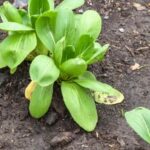The Oregon Coast offers a beautiful and unique environment for vegetable gardening. From the cool, moist climate to the rich coastal soil, there are both challenges and rewards to be found in cultivating a garden in this region.
In this article, we will delve into the intricacies of vegetable gardening on the Oregon Coast, providing valuable insights and tips for success in this specific setting. Whether you’re a seasoned gardener or new to the world of horticulture, understanding the nuances of coastal gardening can make all the difference in your vegetable yields.
One of the main factors that sets vegetable gardening on the Oregon Coast apart from other regions is the climate and soil composition. Navigating these elements successfully is essential for a thriving garden.
Additionally, selecting the right vegetables suited for this environment and understanding when to plant them are crucial components of successful coastal gardening. Furthermore, managing pests and diseases specific to this area, along with proper maintenance techniques such as watering and pruning, are vital for ensuring healthy growth and bountiful harvests.
Throughout this comprehensive guide, we will cover everything from understanding the climate and soil conditions of the Oregon Coast to choosing suitable vegetables for optimal growth. We will also delve into effective garden design and layout strategies, seasonal planting guides tailored to this region’s unique climate, pest and disease management tips, as well as essential maintenance practices.
Additionally, we will offer insights into harvesting your vegetables at their peak flavor and quality. From novice gardeners seeking to establish their first coastal vegetable garden to experienced horticulturists looking to enhance their knowledge of Oregon Coast gardening, this article aims to provide valuable information for all levels of expertise.
Understanding the Climate and Soil
The Oregon Coast presents unique challenges for vegetable gardening, particularly when it comes to the climate and soil. Understanding these factors is crucial for successfully navigating the coastal environment and establishing a thriving vegetable garden. The cool, moist climate and sandy, acidic soil characteristic of the Oregon Coast require specific strategies for successful vegetable gardening.
When it comes to the climate, gardeners on the Oregon Coast can expect cool summers, mild winters, and high levels of precipitation. This presents both challenges and opportunities for vegetable gardening.
On one hand, the mild temperatures enable a longer growing season for certain crops, while the high rainfall can lead to issues such as waterlogged soil and increased risk of certain diseases. It’s important to choose vegetables that are well-suited to these conditions and to implement proper drainage systems in your garden beds to prevent waterlogging.
In terms of soil, the sandy and acidic nature of coastal soils can be a hurdle for vegetable gardening. Sandy soils drain quickly but struggle with water retention and nutrient availability, while acidic soils may require amendments to raise pH levels and improve fertility.
Testing your soil and amending it as needed is essential for providing the best possible growing conditions for your vegetables. Additionally, incorporating organic matter such as compost or well-rotted manure can help improve soil structure and fertility for your vegetable plants.
To navigate these challenges successfully, consider the following tips:
- Choose vegetables that thrive in cool, moist climates
- Implement proper drainage systems in your garden beds
- Test your soil and amend it as needed
- Incorporate organic matter such as compost or well-rotted manure
By understanding the unique climate and soil conditions of the Oregon Coast, you can take proactive steps to create an environment that supports healthy growth for your vegetable garden.
Choosing the Right Vegetables
When it comes to vegetable gardening on the Oregon Coast, choosing the right vegetables is crucial for a successful and bountiful harvest. The cool, moist climate of the Oregon Coast presents unique challenges for growing vegetables, but with the right selection of crops and some strategic planning, you can still enjoy a thriving garden. Here are some tips for choosing the best crops for vegetable gardening on the Oregon Coast.
Understanding Coastal Growing Conditions
Before selecting your vegetables, it’s important to understand the specific growing conditions of the Oregon Coast. The coastal climate is characterized by mild temperatures, high humidity, and regular fog and drizzle. The soil is often acidic and sandy, with good drainage but low fertility. When choosing vegetables for your garden, look for varieties that are well-suited to these conditions.
Best Crops for the Oregon Coast
Some vegetables thrive in the cool, maritime climate of the Oregon Coast. Leafy greens such as kale, lettuce, spinach, and Swiss chard are excellent choices for coastal gardens. Root vegetables like carrots, beets, and radishes also perform well in this environment. Other suitable crops include broccoli, cauliflower, peas, Brussels sprouts, and cabbage. These vegetables can tolerate cool temperatures and benefit from the moisture in the air.
Tips for Successful Growth
To ensure successful growth of your chosen vegetables on the Oregon Coast, it’s important to select varieties that have been specifically bred for cooler climates. Look for cold-tolerant or early-maturing varieties of your favorite vegetables to maximize their chances of thriving in a coastal environment. Additionally, consider using raised beds or containers filled with rich organic soil to provide optimal growing conditions for your vegetable plants.
By carefully selecting the right vegetables and following these tips for successful growth in a coastal environment like that found on the Oregon Coast,{” “}you can create a productive and rewarding vegetable garden that thrives despite its unique challenges.
Garden Design and Layout
When it comes to vegetable gardening on the Oregon Coast, maximizing space and utilizing microclimates is essential for optimal growth. The coastal environment presents unique challenges, such as high winds and salt exposure, which can impact the success of your garden. However, with the right design and layout, you can create a thriving vegetable garden that takes advantage of the natural elements.
To make the most of limited space in a coastal garden, consider using raised beds or container gardening. This allows for better soil drainage and warms up more quickly in the spring, which is especially important in the cool coastal climate. Additionally, vertical gardening techniques, such as trellising for vining crops like tomatoes and beans, can help maximize space and sunlight exposure for your plants.
Utilizing microclimates within your garden can also lead to more successful vegetable growth on the Oregon Coast. For example, areas with southern exposure tend to receive more sunlight and warmth, making them ideal for heat-loving crops like peppers and eggplants. Similarly, planting taller plants like corn or sunflowers strategically to provide shade for more delicate crops can help protect them from harsh coastal winds.
Incorporating these design and layout strategies into your vegetable gardening approach on the Oregon Coast can help you overcome challenges while taking advantage of the unique benefits of this coastal environment. With careful planning and consideration of space and microclimates, you can create a bountiful garden that thrives despite the coastal conditions.
- Consider using raised beds or container gardening
- Implement vertical gardening techniques such as trellising
- Utilize microclimates within your garden by planting strategically
Seasonal Planting Guide
The Oregon Coast presents a unique environment for vegetable gardening, with its cool, moist climate and rich, fertile soil. When it comes to creating a successful vegetable garden in this region, understanding the seasonal planting guide is essential. A month-by-month breakdown of what to plant and when can help maximize your garden’s potential and ensure a bountiful harvest.
In the early spring months of March and April, cool-weather crops thrive on the Oregon Coast. Planting vegetables such as lettuce, spinach, kale, peas, and radishes yield excellent results during this time. These crops can handle the cooler temperatures and occasional light frosts that may still occur in early spring, making them ideal choices for the coastal climate.
As the weather warms up in May and June, it’s time to transition to warm-weather crops. This is when you can start planting tomatoes, peppers, zucchini, cucumbers, and beans in your vegetable garden. The longer days and increasing temperatures create an ideal environment for these vegetables to flourish along the Oregon Coast.
By July and August, your garden should be full of thriving plants ready for harvest. However, you can also continue to sow quick-growing crops like lettuce and radishes for a continuous supply throughout the season. Additionally, consider planting fall crops such as beets, carrots, and brassicas during this time to extend your harvest well into autumn.
The seasonal planting guide plays a crucial role in a successful vegetable gardening venture on the Oregon Coast. By understanding what to plant each month and when to do so based on the unique coastal climate, you can set your garden up for success from early spring through late summer. With careful planning and attention to seasonal variations, you can enjoy a productive vegetable garden year after year in this beautiful coastal region.
Pest and Disease Management
When it comes to vegetable gardening on the Oregon Coast, dealing with pests and diseases is a common challenge that gardeners face. The unique coastal environment can create an ideal breeding ground for various garden threats, making it essential to have effective strategies for prevention and treatment. By understanding the common pests and diseases in the area and implementing proper management techniques, you can help your vegetable garden thrive despite the challenges.
One of the most prevalent pests in vegetable gardening on the Oregon Coast is slugs. The moist, cool climate of the coast provides a perfect habitat for these destructive creatures. To prevent slug infestations, it’s important to keep your garden clean and free of debris where slugs can hide. You can also use organic methods such as diatomaceous earth or beer traps to control slug populations and protect your vegetables.
In addition to pests, coastal gardeners must be vigilant against common plant diseases such as powdery mildew and downy mildew. These fungal infections thrive in high humidity and can quickly spread throughout a garden if left unchecked.
To mitigate the risk of these diseases, choose disease-resistant vegetable varieties whenever possible and practice good sanitation by removing any infected plant material promptly. Implementing proper spacing between plants to allow for adequate air circulation can also help prevent the spread of fungal diseases in your coastal vegetable garden.
Overall, staying proactive in pest and disease management is crucial for successful vegetable gardening on the Oregon Coast. By understanding the specific threats in your area and taking preventive measures, you can enjoy a thriving garden filled with healthy, delicious vegetables throughout the growing season.
Maintaining Your Garden
Proper Watering Techniques
One of the most important aspects of vegetable gardening on the Oregon Coast is proper watering. The coastal environment can bring unpredictable weather patterns, including heavy rainfall and cool temperatures. It is crucial to monitor the moisture level in the soil and adjust your watering schedule accordingly. Consider using a soaker hose or drip irrigation system to deliver water directly to the base of your plants, minimizing water waste and reducing the risk of fungal diseases.
Effective Fertilizing Practices
Due to the unique climate and soil conditions of the Oregon Coast, it is essential to choose fertilizers that are suitable for coastal gardening. Organic fertilizers are often recommended, as they help improve soil structure and promote beneficial microbial activity. Additionally, consider conducting a soil test to determine any nutrient deficiencies and adjust your fertilizing routine accordingly. Be mindful not to over-fertilize, as this can lead to excessive foliage growth at the expense of fruit production.
Pruning for Healthy Growth
Regular pruning plays a key role in maintaining healthy vegetable plants on the Oregon Coast. By removing dead or diseased foliage, you can prevent the spread of pests and diseases while promoting airflow within your garden beds. Additionally, proper pruning helps direct energy towards fruit production rather than excessive vegetative growth. Take care when pruning, as coastal winds can put additional stress on your plants. Properly trained tomato plants are less likely to break in strong winds.
By following these essential tips for watering, fertilizing, and pruning your vegetable plants on the Oregon Coast, you can maximize the success of your garden and enjoy a bountiful harvest despite the unique challenges presented by this coastal environment.
Harvest Time
In conclusion, vegetable gardening on the Oregon Coast presents a unique set of challenges and rewards for gardeners. The coastal environment comes with its own climate and soil considerations that must be understood to successfully grow a variety of vegetables. By choosing the right vegetables, designing an efficient garden layout, and following a seasonal planting guide, gardeners can optimize their vegetable growth on the Oregon Coast.
One of the most critical aspects of vegetable gardening on the Oregon Coast is understanding when and how to harvest your crops for the best flavor and quality. As mentioned in this guide, different vegetables have different signs of readiness for harvest, from color changes to firmness and size.
By paying attention to these indicators, gardeners can ensure that they are picking their vegetables at peak ripeness for optimal taste. Additionally, using sharp tools and harvesting in the early morning or late afternoon can help preserve the freshness and flavor of your vegetables.
As with any type of gardening, it’s essential to maintain your vegetable plants through regular watering, fertilizing, and pruning to support healthy growth. On the Oregon Coast where the weather conditions can be unpredictable, it’s especially important to monitor your garden closely and make adjustments as needed.
By following these tips and staying attentive to your vegetable garden, you can enjoy a bountiful harvest season while savoring the delicious flavors of your home-grown produce on the Oregon Coast.
Frequently Asked Questions
What Veggies Grow on Oregon Coast?
The Oregon Coast’s cool, humid climate makes it ideal for growing certain vegetables. Vegetables like kale, cabbage, broccoli, carrots, and beets thrive in this environment. These crops can handle the coastal weather conditions well.
What Zone Is the Oregon Coast in for Gardening?
The Oregon Coast falls into USDA hardiness zones 8a and 8b for gardening. This means that the region experiences mild winters with minimal frost and cool summers, making it suitable for a variety of plants to grow with proper care and attention.
When Should I Plant My Vegetable Garden in Oregon?
In Oregon, timing is crucial when it comes to planting a vegetable garden. The best time to plant depends on the specific vegetable and the microclimate of your location along the coast.
However, in general, many vegetables can be planted in late winter to early spring after the last frost date has passed. It’s important to consult local gardening resources for more precise planting times based on your exact location within the Oregon Coast area.

If you’re looking to get into vegetable gardening, or are just looking for some tips on how to make your current garden better, then you’ve come to the right place! My name is Ethel and I have been gardening for years. In this blog, I’m going to share with you some of my best tips on how to create a successful vegetable garden.





